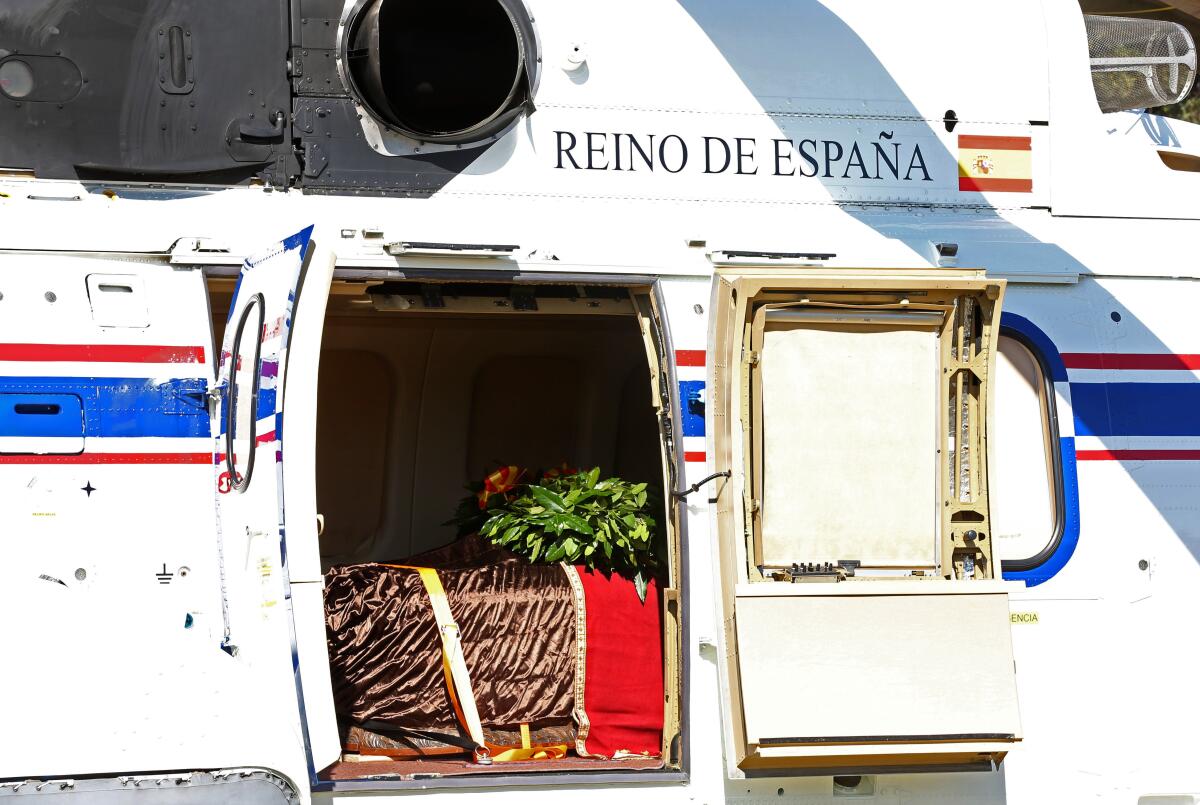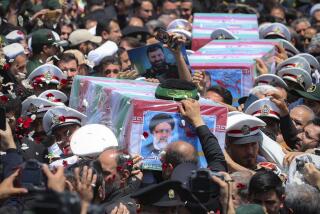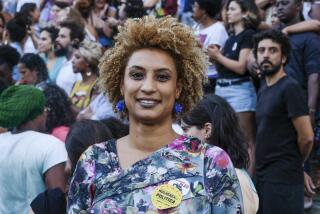For Spain, Franco’s exhumation causes consternation

MINGORRUBIO, Spain — This tree-lined neighborhood north of Madrid is home to some 300 residences, a handful of bars, one playground — and now, two of the 20th century’s most ruthless autocrats.
Though Spanish military dictator Francisco Franco and his Dominican counterpart, Rafael Trujillo, are long dead, their presence loomed large here late last month when Franco’s remains were exhumed from an austere basilica in the Valley of the Fallen and transferred to the quiet cemetery on the edge of Mingorrubio.
The burial ground, surrounded by rolling hills and a weed-covered soccer field, is the final resting place for a handful of prominent right-wing stalwarts: Trujillo, who has been buried there since 1970; Franco’s wife, Carmen Polo; and Luis Carrero Blanco, the Francoist politician whom the Basque terrorist group Euskadi Ta Askatasuna, better known as ETA, assassinated in 1973.
Mingorrubio — a public cemetery to which residents contribute taxes — is not the only place in the Madrid area to house the bodies of dictators.
Fifties-era Venezuelan autocrat Marcos Pérez Jiménez is buried five miles northeast of Franco’s new grave. The sprawling San Isidro cemetery near downtown Madrid holds the graves of Cuban military dictator Fulgencio Batista and, from an earlier time, Croatian strongman Ante Pavelić, whose rule over what was a puppet state of Nazi Germany saw between 200,000 and 300,000 people killed.
“It’s an embarrassment that a democratic state maintains [the graves of dictators],” said Emilio Silva, founder of the Assn. for the Recovery of Historical Memory, which helps exhume mass graves of soldiers killed during the Spanish Civil War of 1936-1939.
Franco’s ties to his new resting place are strong: During his rule, from 1939 to 1975, he lived in the Royal Palace of El Pardo, a mile from the cemetery where he was reburied Oct. 24.
But his disinterment and reburial — a political milestone for the governing Socialist party — has stirred up controversy among his supporters and residents of Spain.
“We’ve worked for so long to overcome our association with Franco,” said Maria Carmen Delgado, a lifelong El Pardo resident and co-founder of a local news site. “And after all we’ve achieved, it’s happened again.”
El Pardo is a sleepy suburb nestled in a national park, more accustomed to weekend hikers than the swarms of journalists who covered Franco’s reburial. Normally Delgado’s website, ElPardo.net, receives at least 200 daily page views. The day of Franco’s exhumation, the website received 2,000 — and reporters called nonstop.
“No one knew how to pronounce Mingorrubio,” said Virginia Delgado, Maria Carmen’s sister and co-founder of the website. During the exhumation, “We had a journalist call us from Japan.”
The exhumation was the result of a year-long legal battle between the Spanish government and the Franco family, who went to court to oppose his removal from the Valley of the Fallen — a mausoleum housing the unidentified remains of thousands of Spanish Civil War soldiers.
Franco, who took full control of power after the civil war, ordered municipalities to dig up graves from around the country using the forced labor of political prisoners. The mausoleum was meant as a monument to his victory.
Though he dedicated it to all those who died, only two graves were marked: Franco’s and that of José Antonio Primo de Rivera, founder of Falangism — the nationalist Catholic political ideology of which Franco was an adherent.
The exhumation — carried out weeks before Spain’s fourth general election in four years — was meant to be deeply symbolic, aimed at helping a country divided over Franco’s legacy come to terms with his dictatorship more than four decades after his death. But far from unifying the country, it cast a spotlight on Spain’s deep political polarization.
Some Spaniards were frustrated Franco was transferred to a public cemetery and not a private one. Franco’s sympathizers are angry his remains were removed without his family’s consent.
Still, said Silva, Franco’s exhumation was a necessary step in Spain’s historical reckoning.
“What has happened with the Valley of the Fallen in recent years? Its meaning was changed,” Silva said. “It became a place that was politically uncomfortable.”
The exhumation lasted several hours and was livestreamed on the state’s public broadcaster.
Franco’s family members carried the coffin from the basilica and cried out, “Long live Spain, long live Franco!”
The image of the family at the Valley of the Fallen was striking, said Francisco Ferrandiz, an anthropologist with the Human and Social Sciences Center in Madrid. When Franco was first buried there in 1975, mourners filled the plaza in front of the basilica.
This time, Franco’s family was alone.
“The family is seen carrying the coffin with the whole plaza empty. The sun is hitting the plaza and there’s a shadow, like the shadow of Francoism,” Ferrandiz said. “It’s very symbolic.”
A helicopter carried the body 21 miles southeast to Mingorrubio, where Franco was reburied in a family mausoleum alongside his wife.
Unlike at the Valley of the Fallen, where the public could lay flowers directly on Franco’s grave, the door to the Mingorrubio mausoleum remains locked and guarded around the clock by police. In the days since, Franco’s supporters have laid yellow and red flowers — the colors of the Spanish flag — on the concrete next to the mausoleum, and hung Spanish flags reading “Always With Us” on the ironwork enclosing it.
On one brisk November evening, the few cemetery visitors had varying opinions on Franco’s exhumation.
Pepa Rodriguez, who lives in the region, said the exhumation was “an embarrassment.”
“Without the permission of the family, he needed to have stayed there,” she said on the mausoleum steps.
But Loli Baron, a Madrid resident who was visiting her father’s grave in Mingorrubio, approved of the move.
“The Valley of the Fallen was for the fallen,” she said. “Franco was not of the fallen.”
The exhumation was particularly significant for Nicolas Sánchez-Albornoz, 93, who watched on television from his Madrid living room.
Seventy years ago, Sánchez-Albornoz and several university friends were arrested and sent to work at Cuelgamuros — what the Valley of the Fallen was previously called.
Sánchez-Albornoz and a friend fled the valley four months after his arrest. With the help of exiled Spanish friends, Sánchez-Albornoz said, they managed to escape in the car of Barbara Mailer, sister of the American author Norman Mailer. They drove to Catalonia, where the Spaniards slipped through forests and crossed into France.
Authorities commenced a nationwide search but never caught Sánchez-Albornoz — and he never returned to the Valley of the Fallen.
Seven decades later, watching the exhumation of the man whose grave he played a part in building, Sánchez-Albornoz said he felt impatient. “I wanted this whole process to conclude,” he said.
But, after years awaiting this moment, Sánchez-Albornoz felt — for a moment — at ease.
“It was time for this to happen.”
More to Read
Sign up for Essential California
The most important California stories and recommendations in your inbox every morning.
You may occasionally receive promotional content from the Los Angeles Times.










